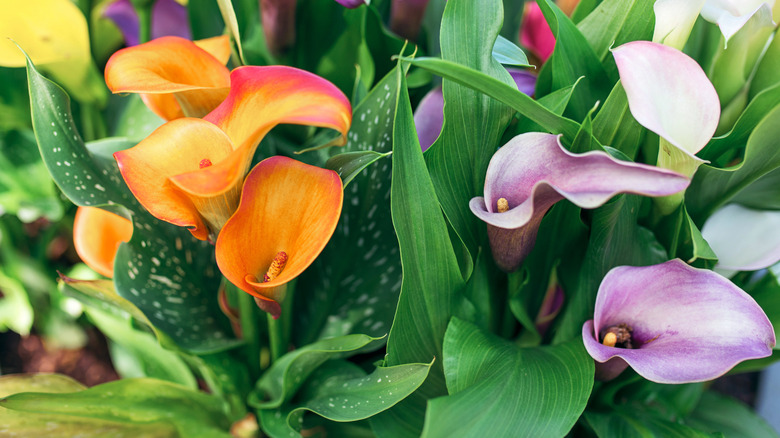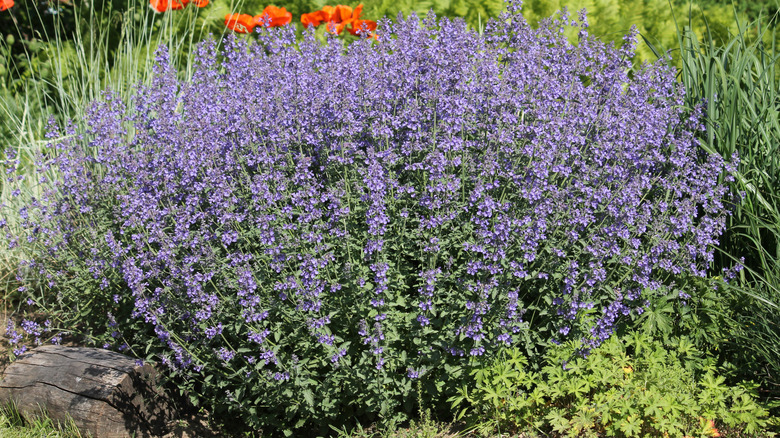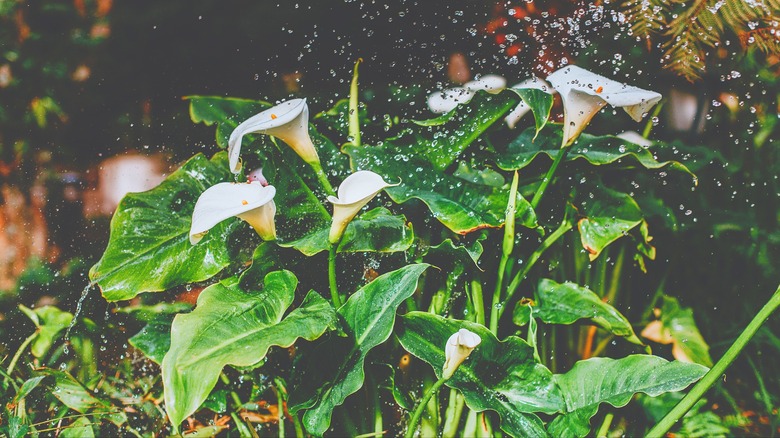The Herb That Should Stay Far Away From Your Calla Lilies
Calla lilies produce stunning blooms that make perfect "thriller" flowers in bouquets and floral arrangements, but if you're trying to grow them in your garden, you could run into a few problems. Aesthetically, calla lilies grow in dense clusters that can leave bare patches in the flower bed around them. When growing calla lilies, you're also likely to have problems with aphids. If you're looking for the perfect plant to complement your cala lilies and support their health, you might be drawn to plant catmint, a low-maintenance perennial with a bushy structure and dainty blooms. In our exclusive interview with Tiffany Selvey, House Digest's Garden Editor and in-house Master Gardener, Selvey explained that "Catmint and calla lilies could make a visually interesting planting combination because they would provide a lot of contrast in their foliage and blooms." Some sources might also suggest growing catmint and calla lilies together because catmint can keep excessive weeds out of the garden and has natural pest-repelling properties, but Selvey says, "In reality, this combination is not ideal."
Catmint and calla lilies may seem visually compatible and even beneficial for each other, but if you try to plant them together in your garden bed, you'll soon see why the two species don't get along. According to Selvey, catmint and calla lilies have differing care needs and will compete for space and resources. Here's why our master gardener advises against planting catmint with your lilies and the alternatives she recommends trying instead.
Catmint crowds out slow-growing calla lilies
It might seem like calla lilies and catmint could fit comfortably beside each other, especially if you buy young plants from the nursery. However, in her exclusive interview with House Digest, Tiffany Selvey gave us a more realistic picture of what could happen as they grow. "Calla lilies and catmint both grow to about 3 feet tall," said Selvey, "Because they're both about the same height, neither can be planted 'under' the other." In addition to their similar height, the two species are likely to butt heads — literally. "Catmint has a full, bushy growth habit with upright stems that feature small leaves and flowers. In contrast, calla lilies have full, flat leaves that grow from a central crown from which tall stalks produce those iconic blooms," Selvey explained, "Since catmint grows to be such a full plant, it would most likely obscure the large calla lily flowers."
Even if they were compatible in height, Selvey warns that these two plants won't be very happy in the same garden bed because of their environmental needs. She says, "While catmint will grow nearly everywhere, calla lilies are much more particular about their growing conditions." Indeed, calla lilies are one of the flowering plants that thrive in soggy soil, containers, and even indoors, but catmint is a drought-tolerant plant that needs bright sunlight to thrive.
Their reproductive methods can also clash. "As a member of the mint family, catmint is an aggressive spreader. Calla lilies are rhizomes that do not reproduce and spread nearly as quickly," Selvey went on to say, "Catmint would almost certainly outcompete the more delicate flower for resources and space."
Wiser ways to support your calla lilies
If you're looking to fill in some bare garden space, what should you plant under calla lilies instead of catmint? As she spoke exclusively with House Digest, Tiffany Selvey noted, "Depending on the cultivar and how densely they are planted, there isn't much room for a plant that grows under the foliage of calla lilies. A low-growing ground cover that doesn't exceed 6 to 8 inches tall would be ideal." Extra large calla lily plants can create areas of shade in underneath their leaves, so consider a few low-growing ground cover plants that love shade and would look lovely next to calla lilies.
If you were originally drawn to catmint for its pest-repelling properties, there are other plants that may provide similar benefits without competing for space. "Signet marigolds (Tagetes tenuifolia) are the smallest species of marigolds and may offer some protection against pests due to their smell," Selvey notes, "The evidence is anecdotal, but many gardeners believe in the power of marigolds for pest deterrence in the garden."
Overall, your calla lilies will probably do best when they're allowed a solo performance. Instead of seeking out companion plants, Selvey suggests other easy methods to keep the calla lilies healthy and aphid-free. "Spraying them off with a garden hose is the cheapest and easiest way to manage this pest," she says. If your aphids are extra tough, Selvey states, "A spritz of neem oil or soapy water can also be effective. Just be sure to keep all pesticides, even organic ones, away from calla lily blooms to prevent harm to beneficial insects that visit."


